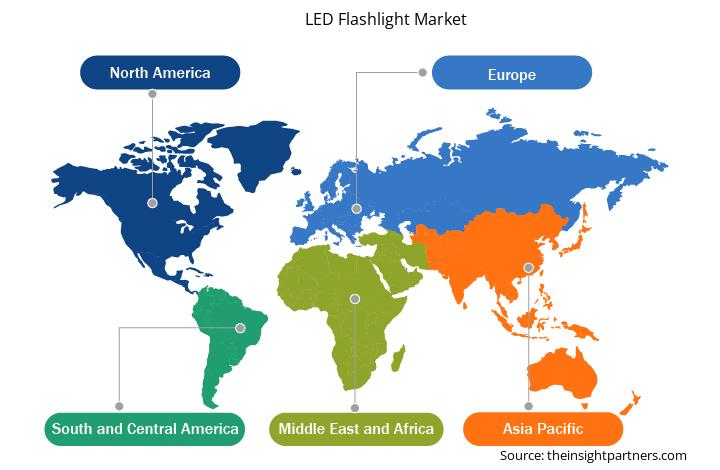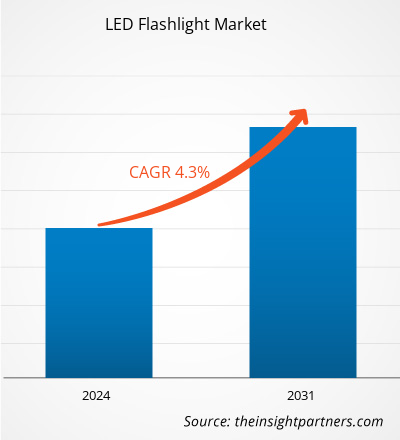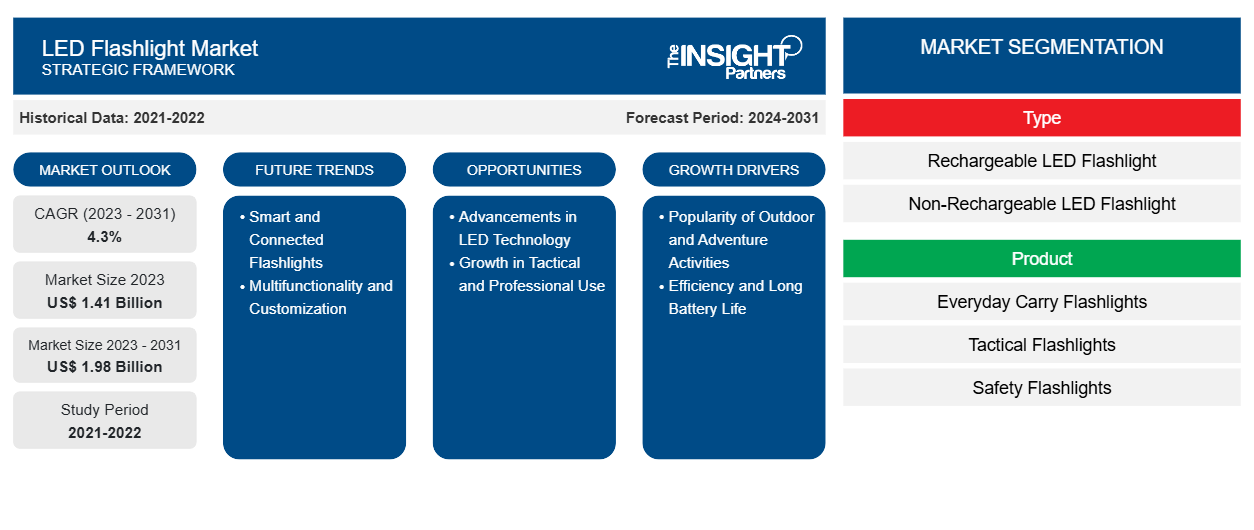Se espera que el tamaño del mercado de linternas LED alcance los 1.980 millones de dólares estadounidenses en 2031, frente a los 1.410 millones de dólares estadounidenses en 2023. Se estima que el mercado registrará una CAGR del 4,3 % durante el período 2023-2031. Es probable que la creciente demanda de linternas inteligentes y conectadas traiga nuevas tendencias al mercado en los próximos años.
Análisis del mercado de linternas LED
La creciente popularidad de las actividades al aire libre y de aventura, así como la eficiencia y la larga duración de la batería de las linternas LED, están impulsando el crecimiento del mercado de las linternas LED . A medida que más personas participan en actividades al aire libre, como acampar, hacer senderismo y cazar, existe una creciente necesidad de iluminación portátil y confiable. Además, las linternas LED son muy eficientes energéticamente, ya que consumen menos energía y tienen una mayor duración de la batería que las luces incandescentes o halógenas estándar. Además, se espera que los avances en la tecnología LED y el crecimiento del uso táctico y profesional creen oportunidades lucrativas para el crecimiento del mercado de las linternas LED. Se espera que las linternas inteligentes y conectadas y la multifuncionalidad y personalización de las linternas LED traigan nuevas tendencias al mercado de las linternas LED.
Descripción general del mercado de linternas LED
Las linternas LED son tecnológicamente avanzadas y pueden satisfacer considerablemente más que las necesidades básicas del hogar. Son más brillantes, más eficientes y más confiables que las linternas estándar. Las linternas LED se utilizan para una variedad de propósitos, incluidos escenarios de emergencia, actividades al aire libre como campamentos y caminatas, operaciones militares y policiales, inspecciones industriales y transporte personal diario. Son fundamentales para la seguridad del hogar, el mantenimiento del automóvil, la fotografía, los exámenes médicos y la investigación científica. Su alta eficiencia energética, longevidad y luz intensa y enfocada las hacen indispensables en una variedad de aplicaciones. El mercado de linternas LED también se beneficia del cambio hacia productos sostenibles, ya que las linternas LED son más eficientes energéticamente y duran más que la iluminación incandescente o fluorescente tradicional .
Personalice este informe según sus necesidades
Obtendrá personalización en cualquier informe, sin cargo, incluidas partes de este informe o análisis a nivel de país, paquete de datos de Excel, así como también grandes ofertas y descuentos para empresas emergentes y universidades.
-
Obtenga las principales tendencias clave del mercado de este informe.Esta muestra GRATUITA incluirá análisis de datos, desde tendencias del mercado hasta estimaciones y pronósticos.
Impulsores y oportunidades del mercado de linternas LED
Eficiencia y batería de larga duración
Las linternas LED son muy eficientes energéticamente, consumen menos energía y tienen una mayor duración de la batería que las luces incandescentes o halógenas estándar. Las linternas LED consumen menos energía para producir la misma luz o incluso más, lo que las convierte en la opción preferida para linternas. Esto es particularmente importante para los usuarios que dependen de las linternas para actividades al aire libre, emergencias o uso profesional, donde maximizar la duración de la batería es esencial. Las linternas LED son cada vez más populares a medida que los consumidores y las empresas valoran la sostenibilidad y las soluciones rentables debido a sus menores costos operativos y menor impacto ambiental. Varios actores en todo el mundo ofrecen linternas LED que son eficientes y ofrecen una larga duración de la batería. Por ejemplo, Anker's Community ofrece Bolder LC90 de Anker, que es una linterna LED de alta eficiencia y bajo costo diseñada para el uso diario. Tiene una duración de batería de hasta 6 horas con alto brillo (900 lúmenes) y se puede recargar mediante USB-C, lo que es una característica conveniente para los usuarios actuales. Además, la Fenix PD36R es una linterna LED recargable muy popular entre los entusiastas de las actividades al aire libre, los excursionistas y los campistas. Está alimentada por una batería de iones de litio recargable 21700, que puede durar hasta 115 horas en la configuración de brillo más baja y 1,5 horas en la configuración más alta (1600 lúmenes). La larga duración de la batería es fundamental en exteriores y situaciones de emergencia, donde el acceso a fuentes de energía es limitado. Una linterna, como la Fenix PD36R, permite a los usuarios confiar en un solo dispositivo durante períodos prolongados, lo que la hace perfecta para expediciones de varios días o situaciones de emergencia que requieren una iluminación constante y confiable. Por lo tanto, la eficiencia y la larga duración de la batería de las linternas LED están impulsando el crecimiento del mercado.
Crecimiento en el uso táctico y profesional
Se prevé que la demanda de linternas profesionales y tácticas aumente en áreas como las fuerzas del orden, el ejército , la marina, las búsquedas y rescates y los bomberos. Estas industrias necesitan linternas de alto rendimiento, duraderas y multifuncionales con características como una salida de alto brillo, impermeabilidad y una mayor duración de la batería. Los fabricantes tienen la opción de crear linternas especiales que satisfagan las necesidades de estos profesionales. Los militares prefieren focos tácticos que se puedan colocar en un arma o armadura. Las linternas militares deben instalarse para permitir el uso con manos libres, ya que las armas que se llevan requieren ambas manos. Varios actores ofrecen linternas LED para uso táctico y profesional. Por ejemplo, la linterna Streamlight ProTac HL-X proporciona hasta 1000 lúmenes de brillo. Utiliza LED para prolongar la vida útil de la batería, lo que es fundamental para el personal militar y de las fuerzas del orden.
El personal de la Marina recomienda utilizar una linterna tan brillante que pueda calmar situaciones tensas. El uso de una linterna de alta luminosidad puede evitar que los espectadores identifiquen y evalúen a la persona que lleva la luz. Evitar la línea de visión en una pelea con armas es una estrategia poderosa que puede usarse tanto en usos civiles como militares. Además, en una emergencia, una linterna táctica puede salvar vidas. La luz brillante se puede utilizar para hacer señales de ayuda a larga distancia. Si uno se pierde en el bosque o se queda varado al costado de la carretera, una linterna táctica con luz estroboscópica o modo SOS puede ayudar a los rescatistas a encontrarlo más rápido. Algunos modelos incluso contienen lentes o filtros de colores que se pueden usar para indicar ciertas formas de incomodidad. Por lo tanto, se espera que el aumento del uso táctico y profesional de las linternas LED ofrezca importantes oportunidades potenciales para el mercado.
Análisis de segmentación del informe de mercado de linternas LED
Los segmentos clave que contribuyeron a la derivación del análisis del mercado de linternas LED son el tipo, el producto y la aplicación.
- Según el tipo, el mercado se segmenta en linternas LED recargables y linternas LED no recargables. El segmento de linternas LED recargables dominó el mercado en 2023.
- Según el producto, el mercado está segmentado en linternas de seguridad, linternas de uso diario y linternas tácticas. El segmento de linternas de uso diario dominó el mercado en 2023.
- En términos de aplicación, el mercado de linternas LED se clasifica en residencial, comercial, militar y policial. El segmento residencial dominó el mercado en 2023.
Análisis de la cuota de mercado de las linternas LED por geografía
- El mercado de linternas LED está segmentado en cinco regiones principales: América del Norte, Europa, Asia Pacífico (APAC), Medio Oriente y África (MEA) y América del Sur y Central.
- La región de Asia Pacífico dominó el mercado de linternas LED, seguida de Europa y América del Norte. La rápida urbanización en China, India e Indonesia ha aumentado la demanda de soluciones de iluminación que sean compactas, duraderas y energéticamente eficientes. En las ciudades, las linternas LED se utilizan no solo para la preparación ante emergencias, sino también para actividades nocturnas, como desplazamientos y seguridad personal. Los productores con sede en China están desarrollando nuevas tecnologías LED que ofrecen una mayor salida de lúmenes, mayor duración de la batería y mayor durabilidad. Los rápidos avances en la tecnología LED dieron como resultado el desarrollo de linternas más eficientes, confiables y rentables que atraen a una amplia gama de consumidores. Empresas con sede en China como Xiaomi y Olight han presentado linternas LED inteligentes con características como brillo ajustable, carga USB y opciones de energía solar. Además, diferentes actores del mercado están colaborando para desarrollar linternas LED avanzadas. Por ejemplo, en colaboración con Cree, IMALENT ha aportado un nuevo nivel de brillo y eficiencia al campo de las linternas. IMALENT y Cree LED han revolucionado sin lugar a dudas el campo de las linternas con su tecnología de vanguardia e innovaciones revolucionarias. Su colaboración marcó el inicio de una nueva era de soluciones de iluminación superbrillantes y confiables que se adaptan a una amplia gama de aplicaciones, incluidas las aventuras al aire libre, la preparación para emergencias o el uso profesional.
Perspectivas regionales del mercado de linternas LED
Los analistas de Insight Partners explicaron en detalle las tendencias y los factores regionales que influyen en el mercado de linternas LED durante el período de pronóstico. Esta sección también analiza los segmentos y la geografía del mercado de linternas LED en América del Norte, Europa, Asia Pacífico, Oriente Medio y África, y América del Sur y Central.

- Obtenga datos regionales específicos para el mercado de linternas LED
Alcance del informe de mercado de linternas LED
| Atributo del informe | Detalles |
|---|---|
| Tamaño del mercado en 2023 | 1.410 millones de dólares estadounidenses |
| Tamaño del mercado en 2031 | 1.980 millones de dólares estadounidenses |
| CAGR global (2023 - 2031) | 4,3% |
| Datos históricos | 2021-2022 |
| Período de pronóstico | 2024-2031 |
| Segmentos cubiertos |
Por tipo
|
| Regiones y países cubiertos |
América del norte
|
| Líderes del mercado y perfiles de empresas clave |
|
Densidad de actores del mercado de linternas LED: comprensión de su impacto en la dinámica empresarial
El mercado de linternas LED está creciendo rápidamente, impulsado por la creciente demanda de los usuarios finales debido a factores como la evolución de las preferencias de los consumidores, los avances tecnológicos y una mayor conciencia de los beneficios del producto. A medida que aumenta la demanda, las empresas amplían sus ofertas, innovan para satisfacer las necesidades de los consumidores y aprovechan las tendencias emergentes, lo que impulsa aún más el crecimiento del mercado.
La densidad de actores del mercado se refiere a la distribución de las empresas o firmas que operan dentro de un mercado o industria en particular. Indica cuántos competidores (actores del mercado) están presentes en un espacio de mercado determinado en relación con su tamaño o valor total de mercado.
Las principales empresas que operan en el mercado de linternas LED son:
- Productos Bayco Inc.
- Productos de la costa
- Duracell Inc
- Browning
- Ledlenser GmbH & Co. KG
- Dorcy Internacional, Inc.
Descargo de responsabilidad : Las empresas enumeradas anteriormente no están clasificadas en ningún orden particular.

- Obtenga una descripción general de los principales actores clave del mercado de linternas LED
Noticias y desarrollos recientes del mercado de linternas LED
El mercado de linternas LED se evalúa mediante la recopilación de datos cualitativos y cuantitativos a partir de una investigación primaria y secundaria, que incluye publicaciones corporativas importantes, datos de asociaciones y bases de datos. A continuación, se enumeran algunos de los avances en el mercado de linternas LED:
- COAST, líder mundial en tecnología de iluminación portátil LED y cuchillos, presentó el año pasado la linterna de bolsillo SLAYER con críticas excepcionales. Una linterna de mano elegante y delgada, perfecta para el uso diario, ahora tiene opciones adicionales de modo de luz roja o un puntero láser para mayor facilidad y seguridad. La serie de linternas SLAYER es resistente al agua y al polvo con materiales de primera calidad aptos para el trabajo más duro. La forma rectangular plana del marco de aluminio se desliza fácilmente dentro y fuera de los bolsillos y se asegura de forma segura con el clip de bolsillo de metal extraíble. Es un accesorio perfecto para llevar de viaje para cualquier trabajo. (Fuente: COAST, comunicado de prensa, mercado 2024)
- Nite Ize, un fabricante líder de productos innovadores basados en soluciones, lanzó la linterna táctica recargable de largo alcance INOVA T4R. Disponible en tiendas minoristas a fines del verano, la linterna montada en la base cuenta con un impresionante haz de luz de 1000 metros para brillar en misiones críticas y condiciones extremas. "La nueva linterna de largo alcance INOVA T4R es un verdadero triunfo de la ingeniería", dijo Rick Case, fundador y director ejecutivo de Nite Ize. "Con un alcance efectivo de hasta un kilómetro, está preparada para ser una herramienta fundamental para los equipos de rescate y más allá". (Fuente: Nite Ize, comunicado de prensa, junio de 2023)
Informe de mercado de linternas LED: cobertura y resultados
El informe "Tamaño y pronóstico del mercado de linternas LED (2021-2031)" proporciona un análisis detallado del mercado que cubre las áreas mencionadas a continuación:
- Tamaño del mercado de linternas LED y pronóstico a nivel global, regional y nacional para todos los segmentos clave del mercado cubiertos bajo el alcance
- Tendencias del mercado de linternas LED, así como dinámicas del mercado como impulsores, restricciones y oportunidades clave
- Análisis PEST y FODA detallados
- Análisis del mercado de linternas LED que cubre las tendencias clave del mercado, el marco global y regional, los principales actores, las regulaciones y los desarrollos recientes del mercado
- Panorama de la industria y análisis de la competencia que abarca la concentración del mercado, análisis de mapas de calor, actores destacados y desarrollos recientes para el mercado de linternas LED
- Perfiles detallados de empresas
- Análisis histórico (2 años), año base, pronóstico (7 años) con CAGR
- Análisis PEST y FODA
- Tamaño del mercado, valor/volumen: global, regional y nacional
- Industria y panorama competitivo
- Conjunto de datos de Excel
Informes recientes
Testimonios
Razón para comprar
- Toma de decisiones informada
- Comprensión de la dinámica del mercado
- Análisis competitivo
- Información sobre clientes
- Pronósticos del mercado
- Mitigación de riesgos
- Planificación estratégica
- Justificación de la inversión
- Identificación de mercados emergentes
- Mejora de las estrategias de marketing
- Impulso de la eficiencia operativa
- Alineación con las tendencias regulatorias























 Obtenga una muestra gratuita para - Mercado de linternas LED
Obtenga una muestra gratuita para - Mercado de linternas LED